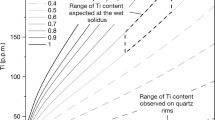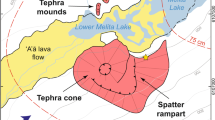Abstract
Models are presented for the cooling of tephra during fallout from explosive eruption columns. All tephra particles are assumed to be spherical and heat loss is considered to occur by radiation and forced convection. Grainsize is the most important control on the cooling. Clasts larger than 25 cm diameter suffer little heat loss, whereas clasts smaller than 1.6 cm diameter are completely cold on deposition. Large clasts form a well-developed chilled margin during fallout and a breadcrust texture can result if vesiculation of the hot interior occurs. The results of these calculations are combined with a model for fallout from the margins of an eruption column to predict the proximal temperature variation with distance from the vent in the deposits. Temperatures high enough for dense welding in proximal fallout deposits can extend from a few hundred metres to nearly 2 km. Extent of the welded facies increases with column height, mean grainsize and magmatic temperature. Welded fallout deposits are only predicted to occur for high temperature silicic and intermediate magmas with temperatures >850°C. These predictions are in good agreement with observations, in that welded fallout deposits have only been documented in high temperature dacites, rhyolites and panellerites. A postulated fallout origin for welded rocks that can be traced significantly further than 2 km from vent must be suspect.
Similar content being viewed by others
References
Achenbach E (1978) Heat transfer from spheres up toRe=6x106. Proc Sixth Int Heat Transfer Conference 5:341–346
Bursik MI, Sparks RSJ, Gilbert JS, Carey SN (1992) Sedimentation of tephra by volcanic plumes I: A study of the Fogo A plinian deposit Sao Miguel (Azores). Bull Volcanol (in press)
Carey S, Sparks RSJ (1986) Quantitative models of the fallout and dispersal of tephra from volcanic eruption columns. Bull Volcanol 48:109–125
Carmichael ISE (1967) The iron titianium oxides of sialic volcanic rocks, and their associated ferromagnesian silicates. Contrib Mineral Petrol 14:36–64
Carslaw HS, Jaeger JC (1959) Conduction of heat in solids. Oxford University Press, Oxford, pp 1–510
Cas RAF, Wright JV (1987) Volcanic successions: modern and ancient. Allen and Unwin, London, p 528
Clark SP JR (1966) Handbook of physical constants. GSA Memoir 9
Dingwell DB, Webb SL (1989) Structural relaxation in silicate melts and non-newtonian melt rheology in geologic processes. Phys Chem Min 16:508–516
Duffield WA (1990) Eruptive fountains of silicic magma and their possible effects on the tin content of fountain-fed lavas, Taylor Creek Rhyolite, New Mexico. GSA Special Paper 246:251–263
Holman JP (1986) Heat transfer: 6th ed. McGraw Hill publications, New York, 676 pp
Houghton JT (1986) The physics of atmospheres, 2nd ed. Cambridge University Press, Cambridge, p 203
Lamb HH (1970) Volcanic dust in the atmosphere, with a chronology and assessment of its meteorological significance. Philos Trans R Soc London A266:425–533
Mahood GA (1984) Pyroclastic rocks and calderas associated with strongly peralkaline magmatism. J Geophys Res 89:8540–8552
Mahood GA, Hildreth W (1986) Geology of the peralkaline volcano at Pantelleria, strait of Sicily. Bull Volcanol 48:143–172
McClelland EA, Druitt TH (1989) Paleomagnetic estimates of emplacement temperatures of pyroclastic deposits on Santorini, Greece. Bull Volcanol 51:16–27
Morton BR, Taylor sir G, Turner JS (1956) Turbulent gravitational convection from maintained and instantaneous sources. Proc R Soc A 234:1–23
Orsi G, Sheridan MF (1984) The Green Tuff of Pantelleria: rheoignimbrite or rheomorphic fall? Bull Volcanol 47:611–626
Rampino MR, Self S (1982) Historic eruptions of Tambora (1815), Krakatau (1883) and Agung (1963), aerosols and climatic impact. Quat Res 18:127–143
Ryan MP, Banks NG, Hoblitt RP, Blevins JYK (1990) The in situ thermal transport properties, and the thermal structure of Mt. St. Helens eruptive units. In: Ryan MP (ed) Magma transport and storage. John Wiley and Sons, Chichester, p 420
Sigurdsson H, Sparks RSJ (1981) Petrology of rhyolitic and mixed magma ejecta from the 1875 eruption of Askja, Iceland. J Petrol 22:41–48
Simkin T, Fiske RS (1983) Krakatau 1883, the volcanic eruption and its effects. Smithsonian Institute Press. Washington DC, p 464
Sparks RSJ (1986) The dimensions and dynamics of volcanic eruption columns. Bull Volcanol 48:3–15
Sparks RSJ, Brazier S (1982) New evidence of degassing processes during explosive eruptions. Nature 295:218–220
Sparks RSJ, Wright JV (1979) Welded airfall tuffs. Geol Soc Am Spec Pap 180:155–165
Sparks RSJ, Bursik MI, Ablay GJ, Thomas RME, Carey SN (1992) Sedimentation of tephra by volcanic plumes part II: Controls on thickness and grainsize variations of tephra fall deposits. Bull Volcanol (in press)
Sparks RSJ, Wilson L, Sigurdsson H (1981) The pyroclastic deposits of the 1875 eruption of Askja Iceland. Philos Trans R Soc London A299:241–273
Walker GPL (1971) Grainsize characteristics of pyroclastic deposits. J Geol 79:696–714
Walker PGL (1973) Explosive volcanic eruptions — a new classification scheme. Geol Rundsch 62:431–446
Walker GPL (1981) Plinian eruptions and their products. Bull Volcanol 44:223–240
Walker GPL, Croasdale R (1971) Two Plinian type eruptions in the Azores. J Geol Soc London 127:17–55
Walker GPL, Wilson L, Bowell ELG (1871) Explosive volcanic eruptions I: The rate of fall of pyroclasts. Geophys J R Astron Soc 22:377–383
Wilson L (1972) Explosive volcanic eruptions II: The atmospheric trajectories of pyroclasts. Geophys J R Astron Soc 30:381–92
Wolff JA, Wright JV (1981) Formation of the Green Tuff Panteleria. Bull Volcanol 44:681–690
Woods AW (1988) The fluid dynamics and thermodynamics of eruption columns. Bull Volcanol 50:169–193
Woods AW, Bursik MI (1991) Particle fallout, thermal disequilibrium and volcanic plumes. Bull Volcanol 53:559–570
Yagi K (1966) Experimental study on pumice and obsidian. Bull Volcanol 29:559–572
Author information
Authors and Affiliations
Rights and permissions
About this article
Cite this article
Thomas, R.M.E., Sparks, R.S.J. Cooling of tephra during fallout from eruption columns. Bull Volcanol 54, 542–553 (1992). https://doi.org/10.1007/BF00569939
Received:
Accepted:
Issue Date:
DOI: https://doi.org/10.1007/BF00569939




